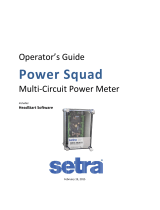Page is loading ...

Application Note:
Modbus/RTU Serial
Addressing Conventions for
SJ200 and L200
Please refer also to the relevant
Inverter Instruction Manual
AN102904-1
Hitachi America, Ltd.
© 2004 Hitachi America, Ltd.

Hitachi America, Ltd.
© 2004 Hitachi America, Ltd.
Modbus/RTU Serial Addressing Conventions for
SJ200 and L200
In the Instruction Manuals for the SJ200 and L200 series inverters, Appendix B contains the function
and parameter tables for Modbus/RTU communications. These tables list coil numbers and register
addresses in hexadecimal (HEX) format for the available inverter parameters. Attempting to access
invalid or reserved addresses will return an error code.
It is important to realize that the hex values in the tables are absolute addresses ONLY within the
inverter. When communicating over a Modbus/RTU network, these values instead represent address
OFFSETS. These offsets must be ADDED to whatever starting address the master device defines. If
the master addressing convention uses decimal values, it is necessary to first convert the HEX
offsets to decimal values. Then add that decimal offset value to the starting address.
EXAMPLE 1
We wish to write to the Output Frequency Command, which is contained in inverter register 0001h
(0001HEX). This represents an offset of “1” in decimal. The data type is “Holding Register”, which is
Modbus Data Type 4, and starts at 40001 (NOT 40000!!! VERY IMPORTANT!!!). The data has a
length of 1 word. So we add the offset of “1” to “40001” and the result is 40002. This is the Modbus
register that will contain the desired value. The data format is “long integer.”
EXAMPLE 2
We wish to read the inverter Output Current Monitor, which is in inverter register 000Bh, which
equates to “11” decimal. So we would add 11 to 40001, and therefore the desired value we would
query is 40012, and a data length of 1 word. The data format is “long integer.”
EXAMPLE 3
We want to write the RUN command in order to start and stop the inverter. This is coil number 0001h,
which corresponds to “1” decimal. Again this is the OFFSET. A coil is Modbus data type “0”, and
starts with address “1”. Thus we add the offset to the starting address, and the desired Modbus coil
number is “2”. The data format is “bit.”
EXAMPLE 4
We would like to read the Scaled Output Frequency Monitor. This is a two-word value, in inverter
registers 0011h (high word) and 0012h (low word). These translate to offset values of 17 and 18 in
decimal, so the desired Modbus registers are 40001 plus 17 and 18, or 40018 and 40019. Therefore,
we would read holding register 40018, with a data length of 2 words. The data would be formatted
as a “swapped long integer.”
The scaling and range of the various parameters is indicated in the table. In example 4, a value of
“6000” would correspond to a value of 60.00 Hz. However in Example 1, the value of “600” would
correspond to 60.0 Hz. The tables also indicate whether a particular coil or register is “read only” or
“read/write.” Please refer to the tables for further details.
/


